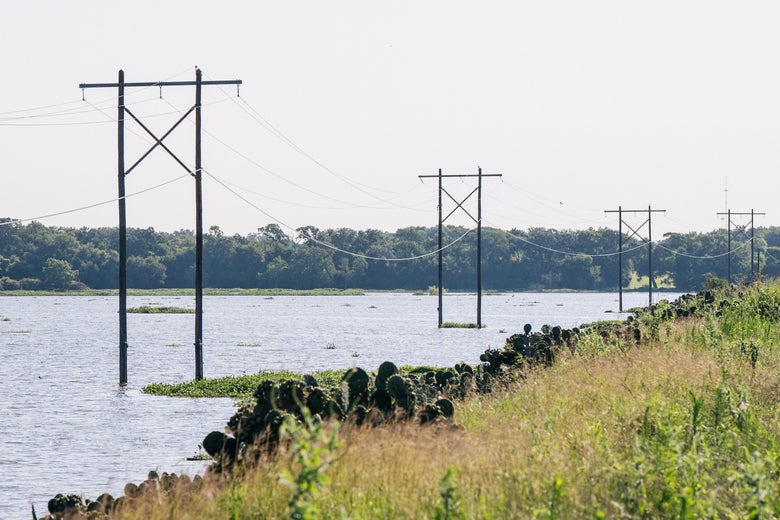Texas likes to be uniquely independent—whether that’s in Lone Star spirit, finding Ted Cruz electable, or even its electrical grid. However, in the first half of 2021, Texas hasn’t been doing so hot at the latter.
Back in February, more than 4 million people in the state lost power during an extreme winter storm. Government officials said in March that at least 111 people died, including an 11-year-old boy; many of those deaths were caused by carbon monoxide poisoning after people burned fuel inside to keep warm. And as Paul Chakalian wrote for Future Tense back in March, the possible health impacts of blackouts don’t just stop there, with water contamination and food storage being of particular concern. The combination of some of the coldest temperatures in decades and unexpected drops in energy supply in Texas led to rolling blackouts that lasted for days in some places.
Which is why it may have been traumatizing on Monday when many Texans began receiving alerts asking them to conserve energy. The request followed significant drops in thermal energy output and a blown transformer at a Texas nuclear plant amid record June demand for power in the state as an early heatwave hits the state. While a lot of the data regarding power plant shutdowns is not public, what is known is that over 12,000 megawatts’ worth of forced outages statewide is leading to a situation where demand during peak hours is getting dangerously close to actual energy output. The situation may make you wonder: Is what happened in February happening again, only with extreme temperatures in the reverse direction?
The short answer: not exactly.
In the winter, much of the blame fell upon the independent agency that oversees electricity distribution to the vast majority of the state: the Electric Reliability Council of Texas. Many experts have argued that ERCOT and Texas’ Public Utility Commission’s emphasis on deregulation and the state’s independent grid have confounded problems. Not only are there minimal opportunities for Texas to import electricity during crises, but there is also no reserve margin (extra available power above demand) enforced in the state—meaning companies have absolutely no incentive to build capacity above expected demand. Therefore, when demand spikes, so does the likelihood of grid failure. But that blame seems to have been at least somewhat misguided: As others have pointed out, grids in Texas’ neighbors—in both the U.S. and Mexico—also experienced outages from the February storm. That suggests the Texas grid’s isolation wasn’t the root cause of the state’s troubles. Still, even staunch supporters of Texas’ independent grid found significant structural problems, including transmission constraints and simple paperwork hiccups that shut power for natural gas facilities in the middle of the February crisis.
And in the summer, interconnections with other grids could relieve some energy stress. Texas’ electrical infrastructure is also in dire need of weatherization upgrades, something that newly passed legislation in the state is working to address. But even then, bureaucracy, paperwork failures, and transmission constraints are giving the state grid issues anyway.
Suffice it to say, Texas’ power situation in the status quo is not ideal. Hence the recent pleas for Texans to cool it on air conditioning and other energy usage. A conservation alert occurs when grid operators request consumers to conserve power during peak demand hours. Joshua D. Rhodes, a postdoctoral researcher in the University of Texas at Austin’s Webber Energy Group, explains that this isn’t that abnormal. Sometimes, unexpected maintenance demands like those being seen currently force grid operators to issue these requests. As ERCOT itself explained in a press release, “The grid is operating exactly as it was designed and intended. The issuance of conservation notices is a common practice and prevents ERCOT from entering emergency conditions.” I’m not exactly sure how massive, unexpected production outages is “exactly as it was designed and intended,” but in all fairness rolling blackouts like February have not occurred—and Rhodes points out that at current temperatures, they are very unlikely to happen. So, the social media backlash to the latest ERCOT conservation alerts is likely a result of increased attentiveness to grid issues following the February debacle.
Still, it is rather unusual “how early in the season [this alert has] been made,” according to Rhodes. And the earliness of these conservation requests should raise some concern, because while there isn’t a crisis right now, Zeke Hausfather—director of climate and energy at the Breakthrough Institute—explains that “it still doesn’t bode well for later this summer” if “unplanned outages continue.”
Rhodes agrees, pointing out what we all know to be true: “It’s gonna get a lot hotter before the summer’s out”—and that means even higher power demands. “If temperatures across the state were, you know, 5 degrees higher,” coupled with “the same level of outages that we have now, we could end up in a situation where we’d have some blackouts, but I don’t think they’d be near as bad as February.”
While it could be just plain bad luck for this much capacity to go offline at one time, it could also be remnant consequences of the stress the grid has already gone under recently. On June 8, Texas Gov. Greg Abbott claimed that the state has “fixed all of the flaws” that led to a grid crisis in February, and that “everything that needed to be done was done to fix the power grid in Texas.” That quote should age about as well as this Ted Cruz tweet:
Future Tense is a partnership of Slate, New America, and Arizona State University that examines emerging technologies, public policy, and society.
